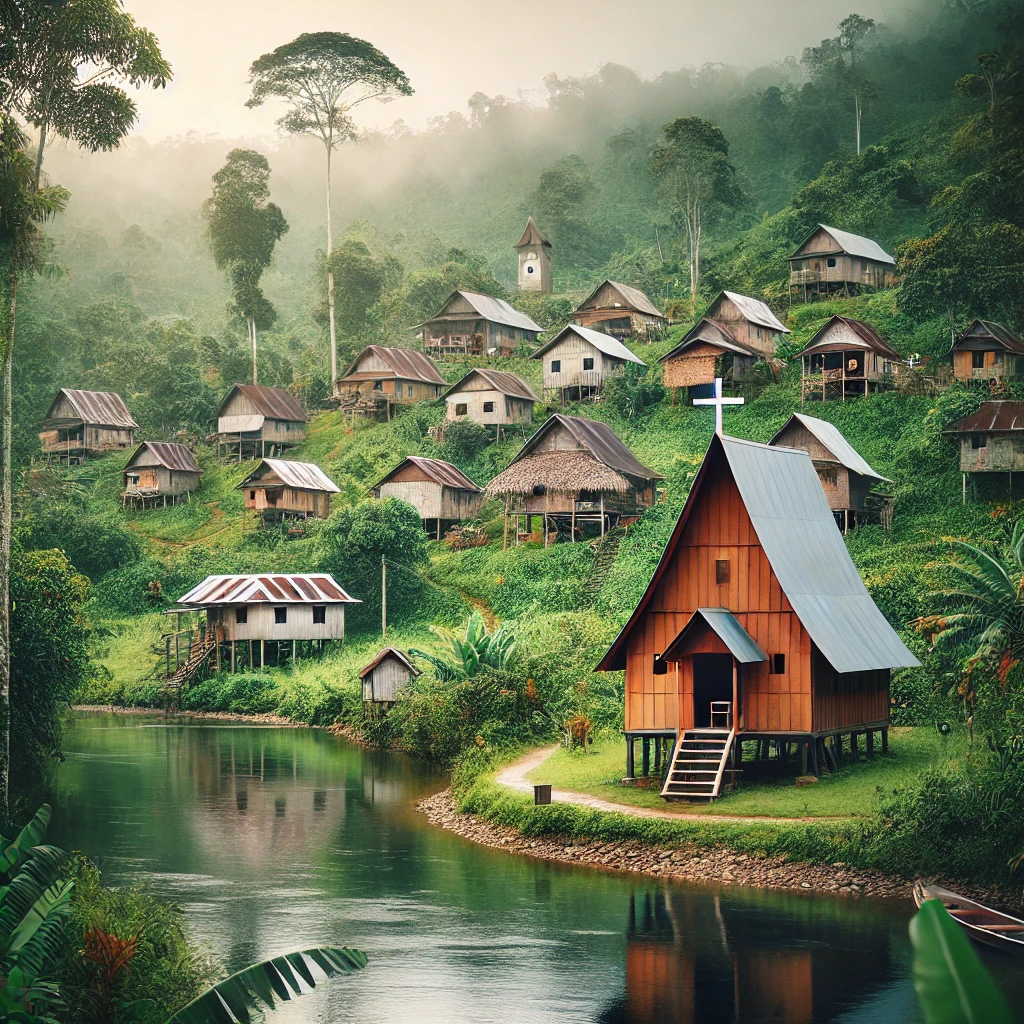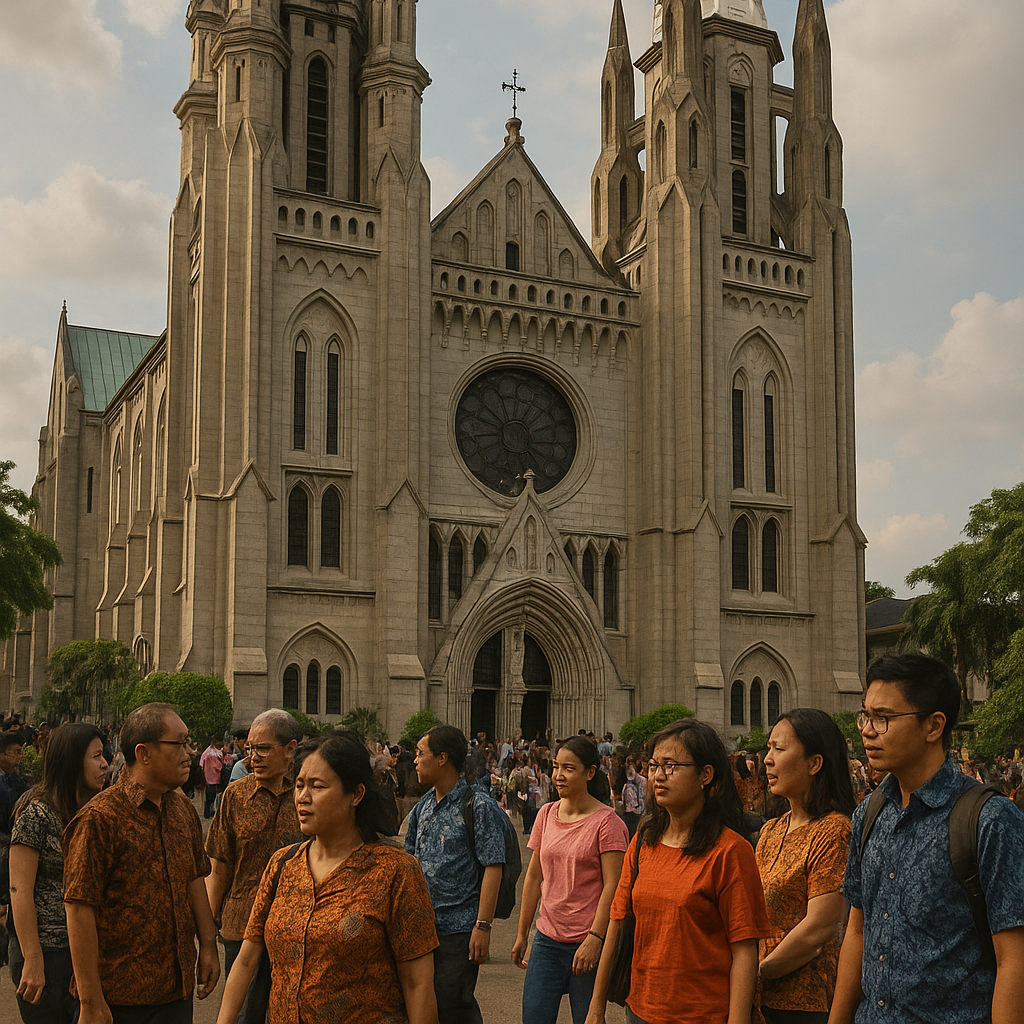The Journey and Acculturation of Christianity in Kayan Mendalam, West Kalimantan: History, Challenges, and Development
theolingua.id – Kayan Mendalam is a region located in Kapuas Hulu Regency, West Kalimantan Province. Geographically, this region is in an inland area with limited access, surrounded by pristine tropical rainforests. Kayan Mendalam is part of the Betung Kerihun National Park, making it an area rich in biodiversity and playing an important role in environmental conservation.
In terms of demography, the population of Kayan Mendalam is dominated by the Dayak people, especially the Dayak Iban and Dayak Tamambaloh sub-tribes. The people in this area generally still maintain ancestral traditions, such as the shifting cultivation system and communal life in longhouses (rumah betang). The languages used besides Indonesian are Dayak Iban and Tamambaloh.
The socio-cultural characteristics of the Kayan Mendalam community are strongly influenced by customs and local wisdom that have been passed down from generation to generation. Customary rituals, such as Gawai Dayak (harvest celebration) and Miring (ritual of respect for ancestors), are still practiced today. Belief in animism and dynamism is also still strongly rooted in some community groups, although the influence of Christianity is quite significant in this region.
Knowing the history and development of Christianity in Kayan Mendalam is important in several aspects. Historically, the entry of Christianity into the interior region of West Kalimantan marked a major change in the lives of local communities, in terms of beliefs, education, and the social system. Churches and missionaries have played a role in bringing education and health services to this region, which ultimately helps improve the quality of life of the community.
In addition, it is also important for us to understand how Christianity has developed over time and the challenges it faces. By understanding these dynamics, in-depth study can provide insight into how Christianity can adapt to local culture without losing the original identity of the people in the Kayan Mendalam region.
From an academic point of view, a study focusing on the development of Christianity in the Kayan Mendalam region can be a reference for studies on the interaction of religion and culture, especially in the context of indigenous communities that are undergoing changes due to the influx of new religions. By understanding the acculturation process that is taking place, we can also contribute to efforts to preserve local culture in the midst of globalisation.
This is because the Kayan Mendalam community has a social structure based on strong customs and kinship systems. Before the introduction of Christianity, the local community adhered to traditional beliefs centred on respect for ancestral spirits and the forces of nature. However, since the arrival of missionaries in the 20th century, Christianity has begun to develop and become part of community life.
In the social context, Christianity has influenced the education and health systems in this area. Many of the first schools and health clinics in Kayan Mendalam were founded by Christian mission organisations. This has contributed to increased literacy and community welfare, although there are still challenges in maintaining a balance between religious teachings and local culture.
From a cultural aspect, the intersection between Christianity and Dayak traditions has created a unique form of acculturation that is still visible today. Some traditional rituals that were previously animistic have been modified to conform to Christian values. For example, in the Gawai Dayak celebration, Christians continue to practice the tradition, but with adjustments that are more ceremonial than spiritual.
In addition, the longhouse tradition, which is a symbol of communal life, is still upheld by most Christians. The values of togetherness and mutual cooperation inherited from their ancestors remain an integral part of daily life, although they are now supported by the teachings of love and togetherness in Christianity.
The history of the entry of Christianity in Kayan Mendalam
The spread of Christianity in Kayan Mendalam can be explained through the theory of diffusion, which states that a religion can spread through social interaction, trade relations, and cultural influences from one group to another. In the context of Kayan Mendalam, Christianity entered through the presence of missionaries who brought new teachings to this region, which were then gradually accepted by the community.
In the early 20th century, several Christian missionaries began to enter the interior of West Kalimantan, including the Kayan Mendalam region. Their presence was not only aimed at spreading religious teachings, but also at providing education and health services to the local community. As in many other areas, Christian missionaries used a social approach to build trust with the local population before introducing Christian teachings more widely.
In the early days of the spread, the Dayak people in Kayan Mendalam were still very attached to animistic and dynamistic beliefs. They believe in ancestral spirits and the forces of nature, which must be honoured through various traditional rituals. However, with the intensification of interaction between the missionaries and the local population, Christianity began to be recognised and accepted, mainly because the values it brought had similarities with the principles of communal life of the Dayak people, such as mutual cooperation and togetherness.
The diffusion of Christianity in Kayan Mendalam did not happen instantly, but through various stages. The missionaries established churches and schools as centres for religious and educational activities. Through education, the younger generation began to recognise and understand Christian teachings, which they then spread further in their communities.
In diffusion theory, religion can spread effectively through social networks, such as family relationships, friendships, and interactions in the community. This is also the case in Kayan Mendalam, where individuals who first accept Christianity often introduce it to their family members and relatives. Over time, more and more families convert to Christianity, eventually forming a larger Christian community in the region.
Even though Christianity was starting to be accepted, the Kayan Mendalam people did not immediately abandon their traditional customs. Instead, there was a process of acculturation between Christianity and local culture. Some traditional practices that did not conflict with Christianity were maintained, such as harvest celebrations and traditional ceremonies in forms that had been adapted to Christian values.
In addition, certain religious symbols and practices were modified to make them more acceptable to the community. For example, the longhouse (rumah betang), which is the centre of Dayak social life, is still used as a place for religious gatherings, in addition to its social function.
Dynamics and Obstacles to the Spread of Christianity in Kayan Mendalam
In the early stages, Christianity was introduced by missionaries who came to Kayan Mendalam. They not only brought religious teachings, but also introduced education, health services, and new social systems that slowly changed the way of life of the local Dayak community. However, because the community was still very strong in animistic and dynamistic beliefs, acceptance of Christianity was initially limited to the small groups that came into direct contact with the missionaries.
Missionaries understood that the success of religious propagation depended not only on the delivery of doctrine, but also on the ability of the religion to adapt to local cultural values. Therefore, they did not directly oppose local traditions, but chose a more persuasive approach that respected the existing culture.
Over time, a process of acculturation occurred in which elements of Christianity blended with local culture. Some Christian religious practices were adapted to make them more easily accepted by the Kayan Deep community. One example is the betang house, which is the traditional longhouse of the Dayak people, used not only as a place of residence, but also as a centre for social and religious activities. As the Christian community grew, betang houses were often used as places of worship before churches were built permanently.
We can see other examples in several traditional ceremonies that were previously animistic in nature and began to be modified to conform to Christian teachings. For example, in the harvest festival, which was previously accompanied by rituals of respect for ancestral spirits, it began to be transformed into an expression of gratitude to God in the form of Christian worship. It did not stop there. In an effort to bridge the old beliefs and new teachings, some Christian communities used local terms to describe the concept of divinity in the Bible, making it easier for the local community to understand.
With the growing influence of Christianity in Kayan Mendalam, changes in the social structure and way of life of the community eventually occurred. Some of the impacts of the spread of Christianity included missionaries establishing schools that not only taught religion, but also reading and writing skills. This helped improve the literacy of the community, which previously relied on oral tradition.
Although many communities retained elements of local culture, some animistic rituals were abandoned or replaced with Christian prayers. For example, the practice of summoning ancestral spirits began to be replaced by prayers to God. The Dayak Christian community also began to form a new identity that combined elements of old beliefs with Christian values. This created a distinctive form of Christianity that was different from the Christian tradition in other regions.
Although Christianity developed in Kayan Mendalam, the process of its spread did not always go smoothly. Some of the obstacles faced in this acculturation process included the fact that many people who still held fast to ancestral beliefs were hesitant to abandon the traditions of their ancestors. In some cases, people who embraced Christianity faced pressure from their own communities because they were considered to be abandoning customs that had been passed down from generation to generation.
The geographical location of Kayan Mendalam, which is in the interior of West Kalimantan, also makes access to this region difficult. Missionaries face obstacles in reaching remote areas, mainly due to limited infrastructure and difficult terrain. As a result, the spread of Christianity takes longer than in more accessible areas.
Initially, limited resources made it difficult for Christian communities to build churches, schools, and other supporting facilities. Many of the first churches that were built were simple structures erected with local materials. However, as the number of Christians increased, religious infrastructure began to develop.
In some cases, the acculturation that occurred between Christianity and traditional beliefs produced a form of syncretism that made it difficult to distinguish between what was still a Christian practice and what was a remnant of animism. This has led to differences in understanding within the Christian community itself and has challenged church leaders in maintaining the purity of Christian teachings.
The acculturation of Christianity with local culture in Kayan Mendalam
The spread of Christianity in Kayan Mendalam has gone through various processes of adaptation to the local culture. To this day, the interaction between Christian teachings and Dayak traditions continues, forming a unique pattern of diversity. The theory of pluralism and social integration can be used to understand how the people of Kayan Mendalam maintain local traditions while accepting Christianity as part of their lives.
The theory of pluralism emphasises that cultural and religious diversity can coexist harmoniously without cancelling each other out. In the context of Kayan Mendalam, pluralism allows the community to maintain their cultural values while practising Christianity. Meanwhile, the theory of social integration explains how Christianity is not only accepted as a new belief, but also plays a role in shaping the social order of the local community through education, social activities, and religious practices that are in harmony with Dayak culture.
Until now, the acculturation of Christianity with Dayak culture in Kayan Mendalam is still developing. Some rituals and customs are still being carried out, but they have changed according to Christian teachings. The people of Kayan Mendalam have formed an identity that harmoniously combines Christian and Dayak cultural elements. Christianity has become part of their lives without completely eliminating local customs and traditions.
In addition, religious pluralism is maintained, where Christians live side by side with those who still adhere to traditional beliefs. There is no compulsion in belief, and traditional ceremonies that do not conflict with Christian teachings are still preserved. Although acculturation continues, modernisation and technological developments are beginning to change people’s lifestyles. The younger generation is more exposed to global culture through social media and modern education, which can influence the way they view the relationship between religion and local culture.
Through the perspective of Pluralism and Social Integration, the acculturation of Christianity in Kayan Mendalam can be understood as an ongoing process. Pluralism allows Christianity and Dayak culture to coexist, while social integration makes Christianity part of community life without having to erase local cultural values.
Until now, this acculturation has continued in various forms, such as the modification of traditional rituals, the use of local languages and symbols in worship, and the role of the church in social life. However, the challenge of modernisation is also a factor that needs to be considered in maintaining the balance between religion and culture in Kayan Mendalam.








